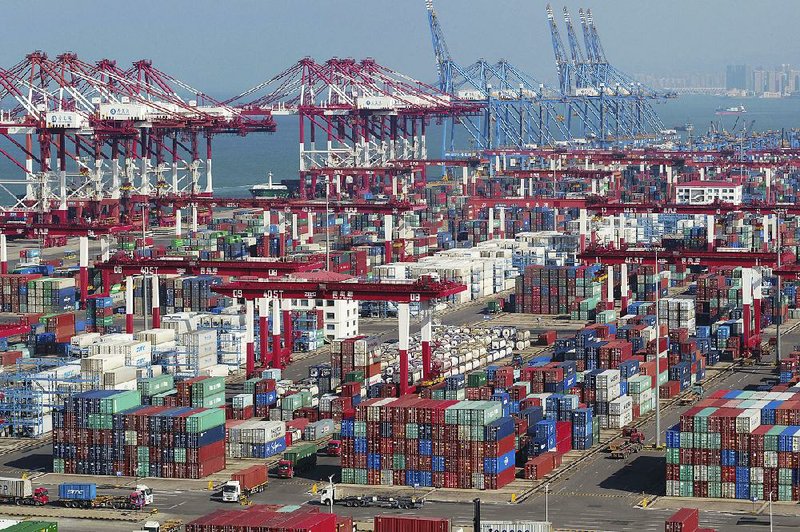BEIJING -- Growth in Chinese exports to the United States ticked up in October as traders rushed to beat a new tariff increase in a battle over Beijing's technology policy.
Shipments to the United States, China's biggest market, have been unexpectedly resilient since President Donald Trump started imposing punitive tariffs on goods in July in a fight over Beijing's technology policy. Exports rose 13.3 percent in October over a year earlier to $42.7 billion, up from September's 13 percent growth, customs data showed Thursday.
China's trade surplus with the United States narrowed to $31.8 billion from September's record $34.1 billion as imports of American goods rose 8.5 percent to $10.9 billion.
Traders are rushing to beat a U.S. tariff increase planned for January, ING economist Iris Pang said in a report. Pang said they are pessimistic this month's planned meeting between Presidents Xi Jinping and Donald Trump in Argentina will yield positive results.
"We expect this front-loading behavior to continue for the rest of 2018," Pang said.
"Continued strong export growth in October reflected accelerated deliveries of export orders ahead of the U.S. tariff hike," said Rajiv Biswas, Asia Pacific chief economist at IHS Markit in Singapore. "Export momentum will likely slow sharply in early 2019."
The Trump administration has imposed a 10 percent charge on $200 billion of Chinese goods that is due to rise to 25 percent in January. Another $50 billion of Chinese goods already is subject to 25 percent duties.
Beijing has responded with tariff increases on $110 billion of American goods. Trump has threatened to expand U.S. penalties to all goods from China.
China's global exports rose 12.6 percent to $217.3 billion in October, down from September's 14.5 percent growth. Imports rose 20.3 percent to $183.3 billion, accelerating from the previous month's 14.3 percent. The global trade surplus was $34 billion, up from September's $31.7 billion.
"While shipments to the U.S. held up well, those to other parts of the world grew even faster, suggesting that global demand is more resilient than expected," Louis Kuijs of Oxford Economics said in a report.
Unexpectedly strong imports contrasted with other signs that China's factory output and other economic activity is cooling.
In the quarter ending in September, economic growth slowed to 6.5 percent over a year earlier, down from the previous quarter's 6.7 percent. A government survey found factory activity in October fell to a two-year low.
Chinese leaders have cut tariffs on non-U.S. goods and promised to encourage imports of consumer goods but reject pressure to roll back plans for state-led development of technology industries.
Washington, Europe and other trading partners complain plans such as "Made in China 2025," which calls for creating Chinese global champions in artificial intelligence, robotics and other fields, violate Beijing's market-opening obligations.
Xi presided over the opening of an import fair Monday in Shanghai that is meant to re-brand China as a welcoming market for other countries' goods. Some 3,600 companies from 152 countries are taking part in the five-day event.
The president promised to open Chinese markets wider, to cut costs for importers and to increase consumer spending power. But he gave no response to foreign complaints about technology policy and investment barriers.
Beijing agreed in May to narrow its trade gap with the United States by purchasing more American soybeans, natural gas and other exports. But Chinese leaders scrapped that deal after Trump's first tariff increases hit.
Chinese companies have been ordered to stop buying American soybeans -- the biggest U.S. export to China -- and find other suppliers and export markets.
China's exports to the 28-nation European Union in October rose 12 percent over a year ago to $35 billion. Imports of European goods increased 14.1 percent to $21.6 billion.
American demand for Chinese goods should weaken next year as tariff increases bite, said ING's Pang. She said exporters might try to sell more to Europe or other Asian economies, but those markets also might be hurt by U.S. import controls.
"Strong export growth may not last very long," said Pang. "We are not particularly optimistic on China export growth in 2019."
Trump and Xi are expected to meet at the upcoming Group of 20 summit in Buenos Aires, with some indication that the two sides are looking to reduce tensions. Still, there's no certainty for business yet that Trump's plan to raise tariffs in January will be abandoned or delayed.
Former U.S. Treasury Secretary Hank Paulson warned Wednesday of the risk of an "economic iron curtain" dividing the world if the two nations fail to resolve their strategic differences.
Information for this article was contributed by Joe McDonald of The Associated Press and by Natalie Lung, Kevin Hamlin and Yinan Zhao of Bloomberg News.
Business on 11/09/2018
